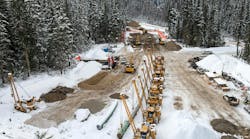PTTEP, Thailand petroleum authority's exploration and production unit, has taken receipt of what the supplier, Pipeline Engineering, Richmond, North Yorkshire, UK, calls a unique gas pipeline low-pressure plug.
PTTEP needed a method of isolating a 32-in. gas pipeline on the PTT Bongkot platform in the South China Sea. The isolation was necessary to allow work on a leaking valve body.
But only a small amount of room was available behind the valve body, precluding use of conventional stoppers, says Pipeline Engineering.
Insertion
The 340-mm long, low-pressure isolation tool is able to fit into the short space between the valve and an upstream T piece. The supplier says that, although in this case the tool will be operating at ambient pressures, it is designed to hold at least 16 bar (approximately 232 psi), four times the possible working pressure.
The stopper will be inserted into the line from an adapted pig launcher 15 m from the valve and pushed by rods past the T piece up to the isolation position downstream of the valve. There it will act as a secondary barrier against any natural gas that may flow back up the out-of-service line towards the valve-changeout area.
Hydraulic hoses connect to the Omnigrip seals and inflate them to isolate the line. During the valve changeout, the tool's annulus between the two seals is monitored to ensure no gas leaks past the seals.
Once the replacement is completed, the seals are deflated and the tool hauled back out of the line.



